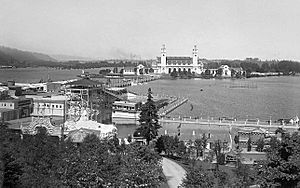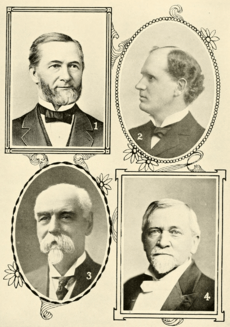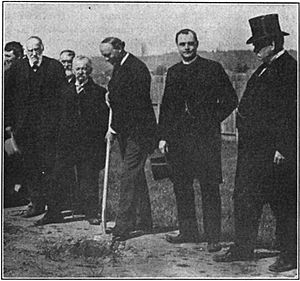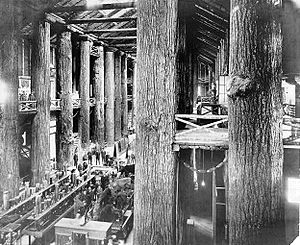Lewis and Clark Centennial Exposition facts for kids

Balloon over Guild's Lake at the Expo
|
|
| Official name | |
|---|---|
| Lewis and Clark Centennial and American Pacific Exposition and Oriental Fair | |
| Details | |
| Dates | June 1, 1905 to October 14, 1905 |
| Location | Portland, Oregon, USA |
| Coordinates | 45°32′16″N 122°42′26″W / 45.537813°N 122.7073395°W |
| Attendance | 2,554,000 |
| Theme | Lewis and Clark Expedition |
| Motto | Westward The Course of Empire Takes Its Way |
| map |  |
The Lewis and Clark Centennial Exposition was a huge event, like a world's fair, held in Portland, Oregon, in 1905. It celebrated 100 years since the famous Lewis and Clark Expedition explored the American West. Even though it wasn't officially called a "World's Fair," it brought in exhibits and visitors from all over the globe.
This big event lasted for about four and a half months. Over 1.6 million people came to visit! It showed off amazing things from 21 different countries. The exposition helped Portland grow a lot, with its population jumping from 161,000 to 270,000 residents between 1905 and 1910.
Contents
Getting Ready for the Fair
Why Portland Hosted the Expo
Portland, Oregon, started as a small town in 1845 and grew into an important city. This was thanks to railroads connecting it to the rest of the country. Portland became a major hub for shipping wheat, flour, and especially timber. Oregon had huge forests, making it a leader in the timber industry.
Even with all this growth, Oregon faced tough economic times in the 1890s. Businesses lost money and jobs were scarce. To help the economy, a local merchant named Dan McAllen suggested holding a big international fair in 1895. The idea didn't take off right away, but by 1900, a group of Portland's most powerful business leaders started planning the event.
Choosing a Theme
The main reason for the fair was to boost Portland's economy. But it also needed a cool theme for publicity. The Oregon Historical Society suggested celebrating the 100th anniversary of the Lewis and Clark Expedition's journey through Oregon.
The organizers combined this historical idea with their goal of economic growth. They gave the fair a long official name: "The Lewis and Clark Centennial and American Pacific Exposition and Oriental Fair." Its motto was "Westward The Course of Empire Takes Its Way." This motto showed the spirit of westward expansion and progress.
How the Fair Was Paid For
Once the theme was set, the organizers started getting support and money. Many businesses, like banks, railroads, and hotels, invested a lot of money. They knew the fair would bring in many visitors and help their businesses. About 3,000 regular citizens also bought stock, hoping to see a return on their investment and support a good cause.
The state government of Oregon also saw the fair's potential. They passed a law to give about $500,000 to help fund the event. The U.S. government also contributed a lot of money and exhibits. This combined effort from businesses, citizens, and the government made the fair possible.
Building the Fairgrounds
Finding the Perfect Spot
After getting money, the organizers needed to find a place to hold the fair. They looked at several locations around Portland. The best choice turned out to be Guild's Lake, on the west side of the Willamette River. Even though it was a bit swampy, it was big enough and had great views of Mount St. Helens.
Guild's Lake was also easy for people to reach. Two trolley lines ran right near the entrance. Visitors could also arrive by steamboat on the river. The fairgrounds were built on land that was later sold for development, but it was leased back to the city for the event.
Designing the Buildings
Many talented people helped design the fairgrounds and buildings. The famous Olmsted Brothers firm, known for designing parks, created the overall layout. They made sure to use the beautiful views from the site.
A team of seven architects designed the fair's buildings. Most of the buildings looked like Spanish Renaissance style, with domes, arches, and red roofs. They were built quickly and cheaply using plaster over wooden frames because they weren't meant to last forever.
The most famous building was the Forestry Building. It was like a giant log cabin, said to be the biggest in the world! It was made from 54 huge, unhewn logs and showed off Oregon's timber products and Native American culture. This building stood until a fire destroyed it in 1964. Today, the World Forestry Center in Portland is a modern version of its spirit.
At night, the fairgrounds glowed with over 100,000 incandescent lights outlining the buildings and bridges. There were also many statues, including one of Sacajawea and Jean-Baptiste which you can still see in Washington Park today.
The Lewis and Clark Exposition
The exposition opened on June 1, 1905, and closed on October 15, 1905. It featured amazing displays from 21 countries and 16 U.S. states. The U.S. government and many private groups also had exhibits.
What You Could See
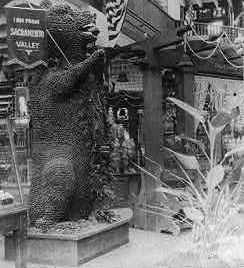
- International Exhibits: Italy had the largest foreign exhibit, with many marble statues. Germany and France also spent a lot on their displays. Japan spent $1 million (a huge amount back then!) on its exhibit, showing beautiful porcelains, silks, and lanterns.
- State Exhibits: Many U.S. states, including California, Washington, and New York, had their own exhibits. Each state usually had a special day to show off its unique features.
- Other Displays: There were big exhibits about farming, new technologies, and music. The famous Mormon Tabernacle Choir sent an exhibit, and the Smithsonian Institution also had a display.
- Controversial Exhibits: Some exhibits, like one featuring Philippines Igorot tribespeople, showed how people lived in other parts of the world. These exhibits were meant to educate visitors about different cultures and regions.
Fun Attractions
Besides the main exhibits, the fair had lots of entertainment:
- An amusement park with rides.
- Various sideshows and concerts.
- Free motion pictures, which were very new and exciting at the time.
- Blimp rides for a unique view of the fair.
- Many vendors selling food and souvenirs.
The fair was also the finish line for a cross-country car race! Sports events, like track and field championships, were held at the nearby Vaughn Street Park.
How the Fair Helped Portland
The Lewis and Clark Exposition was a huge success for Portland's economy. Almost 1.6 million people paid to enter, with an average of 11,600 visitors each day. Tickets cost 50 cents for adults and 25 cents for children.
The fair made a profit of about $85,000, which was unusual for such big events. Investors even got a 21% return on their money! It's estimated that a million visitors from out of town came to Portland, bringing millions of dollars into the local economy. The fair also created 1,000 construction jobs.
What's Left Today
Very little of the original Lewis and Clark Centennial Exposition remains. Most of the buildings were temporary and were torn down in 1906.
- The famous Forestry Building, which was reinforced to become a museum, burned down in 1964. A new museum, the World Forestry Center, was built in its place in Washington Park.
- A few buildings from the fair still stand today, like the Fairmount Hotel and the National Cash Register Building (now a pub).
- About half a million pink "Mme Caroline Testout" rose bushes were planted along Portland's streets for the fair. Many of these beautiful roses are still there today!
- Many people moved to Portland after the fair, leading to a building boom. You can still see sidewalks in East Portland from that time, dated 1910 to 1920.
Guild's Lake, where the fairgrounds were built, was slowly filled in over the years and disappeared by the 1920s. Today, the area is mostly used for industrial purposes.



